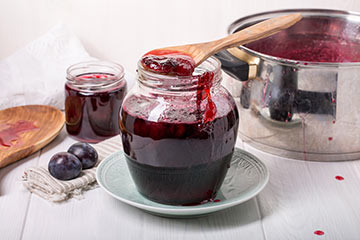
Low-Sugar Preserves

Making jams and jellies is a great way to preserve extra summer fruits, particularly those that might be “imperfect” in their shape or size for eating fresh. But jams and jellies typically have a lot of added sugars, and thus, empty calories. In fact, a high sugar level plays an important role in making jams and jellies, from both a functional and a safety perspective. Sugar helps cause the jam or jelly to actually gel and form its distinctive texture. Sugar also binds the water in the product so microorganisms cannot use it to grow; accordingly, sweet spreads that are higher in sugar have a lower risk of spoiling or of making people sick.
Therefore, if you are canning a sweet spread, it is essential for safety reasons to use and follow a tested recipe. Do not simply reduce the sugar level on your own. If you are freezing a sweet spread and leave out or reduce the sugar level, the spread may not gel and will be runny. Tested recipes for low-sugar jams and jellies are available from such sources as the National Center for Home Food Preservation; it is very important to use one of these tested recipes if you want to make a safe and high-quality healthier sweet spread. Many of the low-sugar recipes are for refrigerated (not canned) spreads, but the recipe in this issue is for a canned low-sugar spread.
Sellers of fruit jams and jellies with “regular” sugar levels generally do not require a license to sell directly to consumers — for example, through farmers markets or farm stands — in Kansas or Missouri, and thus can make those fruit products in a normal home kitchen. However, due to the previously indicated food safety concerns, selling jams and jellies with reduced sugar levels directly to consumers generally requires further testing in both states to determine whether a license is required. In Kansas, the water activity of the low-sugar jam or jelly should be tested, and in Missouri, the pH must be tested in a laboratory to determine whether or not a license is needed.
Sources:
National Center for Home Food Preservation. n.d. “How Do I? … Jam and Jelly.” https://nchfp.uga.edu/how/can7_jam_jelly.html.
Oesterle, Allison M. 2004. “Low Sugar Alternatives for Jams and Jellies.” National Center for Home Food Preservation, April 2004. https://nchfp.uga.edu/tips/summer/Lowsugar_JamsJelliesST.html. (No longer available online.)

Preserving White Peaches
As we get deeper into summer, we turn to a summer favorite — peaches! There are many varieties of peaches, and many can be preserved safely. But avoid canning white peaches. Why, you ask?
Some white-fleshed peaches have a natural pH, or acid content, of above 4.6. That makes those peaches a low-acid food. If the recommendations for canning yellow peaches are used for white peaches, they will likely spoil. And it has happened. At this time, there are no recommendations for safely canning white peaches through either pressure or water-bath canning.
The best options are to eat them fresh or freeze them. See https://www.bookstore.ksre.ksu.edu/pubs/mf1182.pdf for instructions on freezing peaches.
Source: National Center for Home Food Preservation. 2018. “Selecting, Preparing and Canning Fruit: Peaches — Halved or Sliced.” Last revised June 2018. https://nchfp.uga.edu/how/can_02/peach_sliced.html.
Reduced-Sugar Peach-Pineapple Spread

Yield: 5 to 6 half-pint jars
Ingredients:
- 4 cups drained peach pulp (procedure below)
- 2 cups unsweetened crushed pineapple, drained
- ¼ cup bottled lemon juice
- 2 cups sugar (optional)
Notes:
This recipe may be made with any combination of peaches, nectarines, apricots and plums.
This recipe may be made without sugar or with up to 2 cups of sugar, according to taste or preference. Nonnutritive sweeteners may be added. If aspartame (a low-calorie nutritive sweetener) is used, the sweetening power of aspartame may be lost within three to four weeks.
Procedure for preparing pulp:
Thoroughly wash 4 to 6 pounds of firm, ripe peaches. Drain well. Peel and remove pits. Grind fruit flesh with a medium or coarse blade, or crush with a fork (do not use a blender). Place ground or crushed fruit in a 2-quart saucepan. Heat slowly to release juice, stirring constantly, until fruit is tender. Place cooked fruit in a jelly bag or strainer lined with four layers of cheesecloth. Allow juice to drip about 15 minutes. Save the juice for jelly or other uses. Measure 4 cups of drained fruit pulp for making spread.
Instructions for spread:
- Combine the 4 cups of pulp, pineapple and lemon juice in a 4-quart saucepan.
- Add up to 2 cups of sugar, if desired, and mix well.
- Heat and boil gently for 10 to 15 minutes, stirring enough to prevent sticking.
- Fill jars quickly, leaving ¼-inch headspace.
- Adjust lids and process as recommended in table below.
| Recommended process time for Peach-Pineapple Spread in a boiling-water canner, using the hot pack method. |
|||
|---|---|---|---|
| Process time at altitudes of: | |||
| Jar size | 0–1,000 feet | 1,001–3,000 feet | 3,001–6,000 feet |
| Half pint | 15 minutes | 20 | 20 |
| Pint | 20 | 25 | 30 |
Source: National Center for Home Food Preservation. 2017. “Making Jams and Jellies.” Last reviewed March 2017. https://nchfp.uga.edu/how/can_07/peach_pineapple_spread.html.